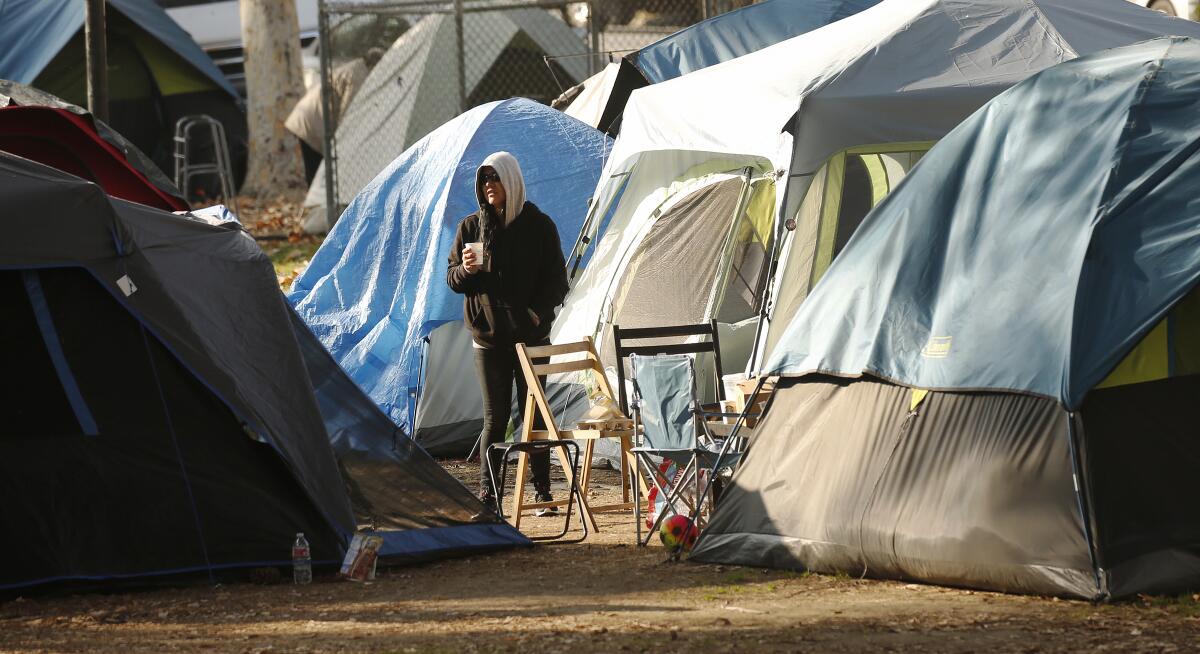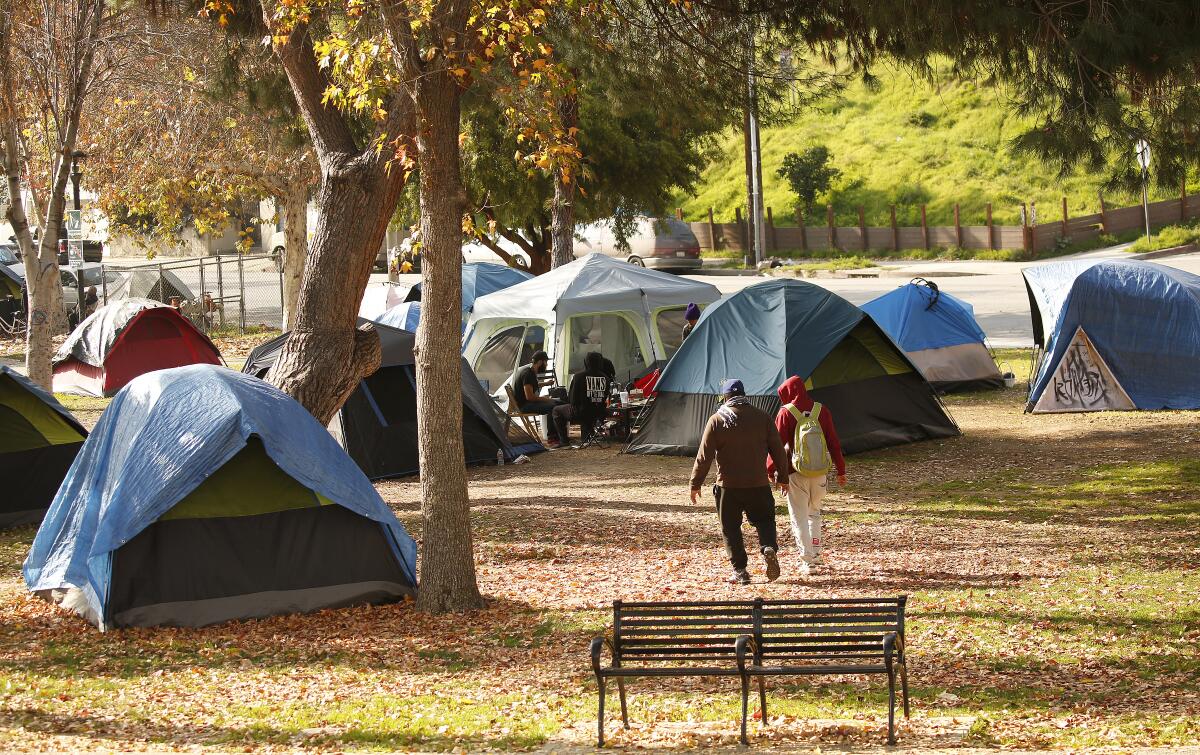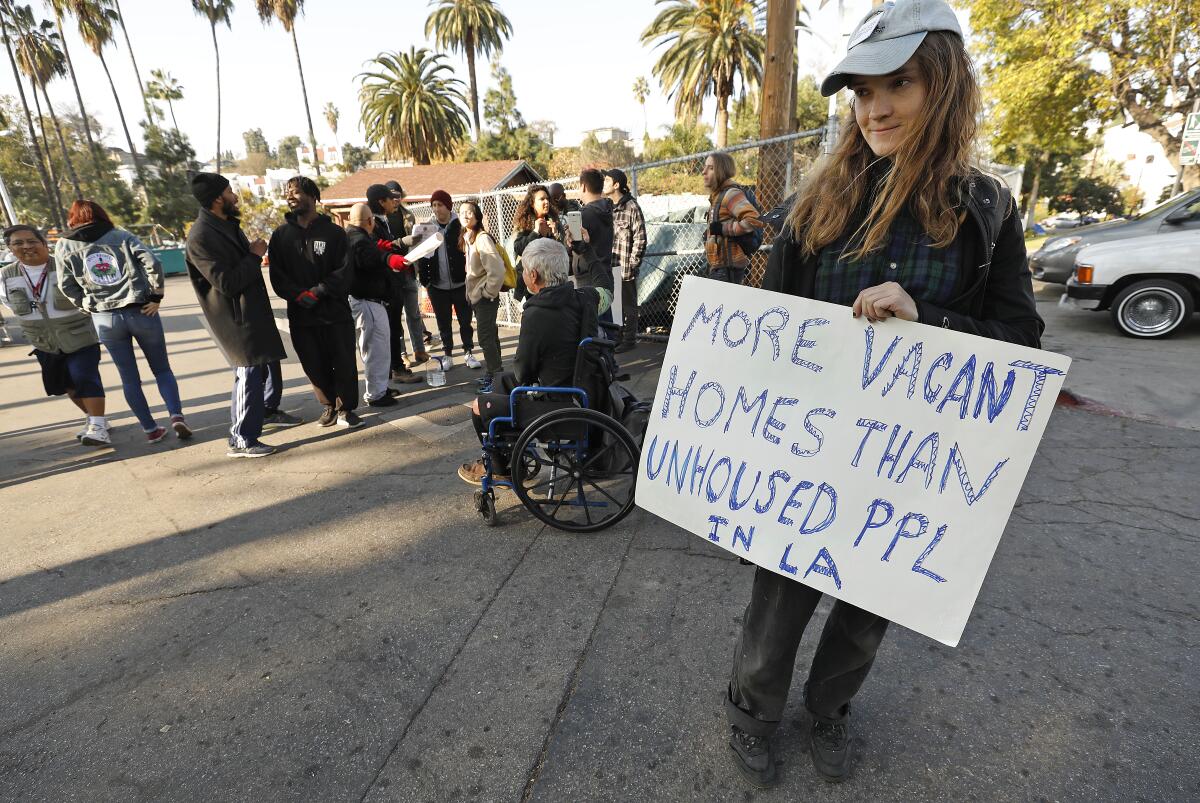Voters could decide if California cities will be punished for not reducing homelessness

- Share via
With public and political pressure mounting to get homeless people off the streets of California, a task force appointed by Gov. Gavin Newsom is recommending that local governments face tough new legal sanctions for failing to make progress.
In a report released Monday, the Council of Regional Homeless Advisors is calling for an amendment to the California Constitution that would create a legally enforceable mandate to reduce the homeless population. The Legislature would have to craft the plan, which would then appear as a statewide ballot measure in November.
If approved by voters, the mandate would allow the state to sue cities and counties — or even itself — if the number of people living outdoors in encampments and vehicles doesn’t decline.
The 13-member task force, led by Sacramento Mayor Darrell Steinberg and L.A. County Supervisor Mark Ridley-Thomas, argues that the state needs to carry a big stick to convince local governments that they will face consequences if they don’t get people off the streets — including the possible loss of local control.
“We’ve tried moral persuasion. We’ve tried economic incentives,” Steinberg said. “But all of it’s optional. Why should this be optional? It shouldn’t be. It mustn’t be. Thousands of people are dying on the streets, and people are telling us this is a priority.”
The far-reaching proposal is certain to stir controversy — both at the Capitol in Sacramento and with local governments across the state. But Steinberg says the mandate is necessary because there are overlapping and convoluted systems of care that sometimes have differing goals and approaches.
Money and responsibility for homelessness programs are split between elected officials in cities and counties and the administrators of “continuums of care” — the local and regional agencies created to handle funding and organize the distribution of services for homeless people.
But cooperation and coordination don’t often happen, and some local governments aren’t as aggressive at addressing homelessness as state officials would like.
“There is too much fragmentation,” Steinberg said.
Oakland Mayor Libby Schaaf, another member of the task force, said the proposed mandate represented a way to build trust with residents that the government was addressing what the report described as a “mounting catastrophe.”
A recent report from the U.S. Department of Housing and Urban Development found that homelessness increased in California by more than 16% from 2018 to 2019, leaving more than 151,000 Californians without permanent housing. Nearly 71% — about 108,000 people — are living outdoors in encampments or in vehicles, the highest percentage of any state in the nation.
Oakland has been hit especially hard. Homelessness climbed 47% from 2017 to 2019 in the Bay Area city, according to last year’s point-in-time headcount. As mayor, Schaaf said she would welcome a mandate because it would ensure that surrounding communities weren’t adding to her city’s problems.
“I need other cities to be doing their part because Oakland does not exist on an island,” Schaaf said. “I believe Oakland would pass that accountability test.”
Newsom, speaking Monday in Grass Valley where he was touring homeless facilities, said he broadly supported “the direction they’re going,” but would like to see a pilot program to test the mandate idea. He said he expects a “robust debate” both with and among legislators about the potential ballot measure.
A pilot program could be launched while that debate is under way, Newsom said.
“I think we’ve got to socialize something that is a tectonic shift in the way we’ve done things and what I’ve learned — and you’ve probably heard me say this — is the old wonderful African proverb that if you want to go fast, go alone, if you want to go far, go together,” he said. “We’ll see how far they want to go. ... I’m not giving up on 2020.”
Last week, Newsom unveiled his own expansive plan for addressing homelessness, including more than $1.4 billion to address the lack of shelters as well as healthcare for homeless people. More than half of that money is expected to go directly to local services.
Steinberg, Schaff and Ridley-Thomas each said they would support their cities and counties participating in a pilot program. Ridley-Thomas said he planned on presenting such a resolution to the rest of the Los Angeles County Board of Supervisors on Tuesday. If passed, he said it would require the county to come up with recommendations within 60 days to implement a pilot program.
However, neither Ridley-Thomas nor Steinberg had details on how a local government could fulfill a pilot project on par with the proposed mandate. Steinberg suggested local governments could pass their own ordinances to hold their cities and counties legally accountable to reducing homelessness.
“There is a lot we will have to figure out here,” Ridley-Thomas said.
Graham Knaus, executive director of the California State Assn. of Counties, cautioned that the task force’s plan lacks detail, including the money that would required to ensure that local governments have enough funding to accomplish the goals.
The “recommendations raise a number of key policy issues that are worth exploring, but that certainly require additional detail and conversation to work out how they would be funded,” Knaus said.
The task force report comes as the state prepares to give local governments unprecedented levels of funding to address homelessness. In addition to the money that Newsom proposed in his budget, $640 million in one-time spending approved last year will begin to hit cities and counties in the coming weeks.

The mandate idea marks a step away from — or at least around — the controversy Steinberg sparked with his “right to shelter” idea last year.
That plan would have required a bed to be provided to every homeless person in the state and for homeless people to accept the help. Advocates fear the latter requirement will lead to more law enforcement sweeps of encampments and infringe on people’s civil rights.
Others panned the idea because they believed it would lead to a proliferation of large shelters that would get people off the streets but not necessarily into permanent housing.
Ridley-Thomas called the blowback a “knee-jerk” reaction. The “right to shelter” plan had always been a starting point.
“Why would we want to warehouse people?” he said. “That was what was really in advocates’ craw. They were not appreciating that we don’t have to warehouse people.”
Schaaf said she opposed the “right to shelter” plan because it focused on the short-term goal of getting people indoors and lacked the flexibility of a mandate in allocating resources, such as for rental assistance programs and affordable housing.
Having a mandate, she said, “really starts with accountability, and I think that is really a more successful place to start.”
Erwin Chemerinsky, dean of the UC Berkeley School of Law and an advisor to the state task force, said the mandate, if approved, would accomplish the same thing as the “right to shelter” plan but without a requirement that homeless people accept services.
“This is about the duty of the government to ensure that shelter is available for everyone,” he said. “We can do something without infringing civil liberties. Providing housing and forcing people to use it are two different steps.”
The task force’s recommendation likely will be discussed by the Legislature in the coming weeks, but it is far from certain that it will be adopted and put on the ballot for voters to consider.
Steinberg said the Legislature would have to come up with the final details of how the mandate would be implemented. But the task force, according to its report, has envisioned letting local governments take up to a year to come up with their own benchmarks and then be held to those goals in subsequent years.
If cities or counties miss their benchmarks, the state would have the ability to ask a court to intervene, possibly redirecting money and resources. The mandate, however, would not require that the state monitor or take legal action. Individuals would not have the right to sue.

Although the mandate would give the state legal authority to crack down, the task force also said the state needed to take the lead on creating a unified crisis response. “We lack clarity regarding which levels of government are or should be responsible for funding and implementing various aspects of a response to the crisis of homelessness,” the task force said.
Ridley-Thomas compared what the task force had proposed to the resources that state and local governments devoted to making sure people were able to vote.
“We spend a lot of money making sure people are protected in terms of their rights — multilingual ballots, technology, the whole nine yards,” he said. “It is that kind of apparatus that needs to be put in place to protect people from being homeless.”
Steinberg compared the proposed mandate to other sweeping public policy initiatives, such as the state law to reduce greenhouse gas emissions or the federal requirement to provide free and appropriate education to children with special needs.
“This kind of public policy coupled with the resources gives the resources a much better chance to actually bend the curve,” he said.
Many of the other recommendations in the task force’s report include items that Newsom laid out in his budget last week, including a greater emphasis on preventing homelessness by assisting those on the brink of it, and a focus on mental health and substance abuse services.
Both the governor and the task force also said that Proposition 63, the Mental Health Services Act, which placed a tax on millionaires, should be reexamined to streamline how those dollars could be spent.
More to Read
Sign up for Essential California
The most important California stories and recommendations in your inbox every morning.
You may occasionally receive promotional content from the Los Angeles Times.












